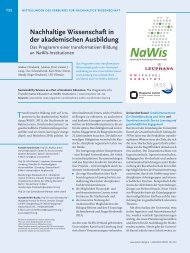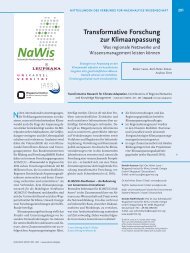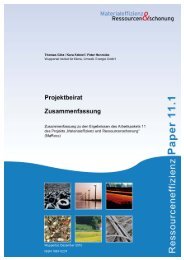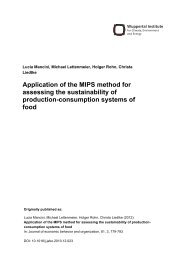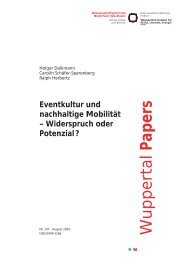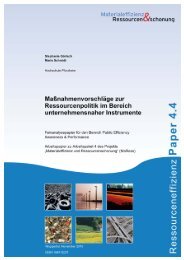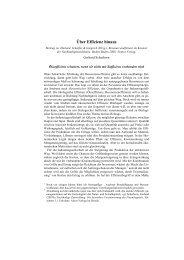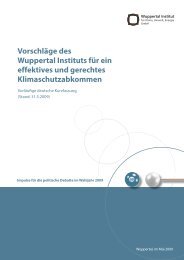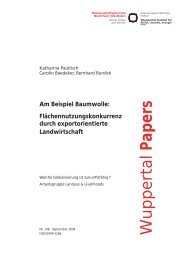Resource Efficiency Atlas - Publication Server of the Wuppertal ...
Resource Efficiency Atlas - Publication Server of the Wuppertal ...
Resource Efficiency Atlas - Publication Server of the Wuppertal ...
You also want an ePaper? Increase the reach of your titles
YUMPU automatically turns print PDFs into web optimized ePapers that Google loves.
Effects Region and Country<br />
Material<br />
Water m 2<br />
Energy<br />
Surface<br />
fields<br />
Europe<br />
<strong>Resource</strong> <strong>Efficiency</strong><br />
The wave power station uses renewable energy <strong>of</strong> waves<br />
and emits no CO during <strong>the</strong> utilization phase. The plant<br />
2<br />
is designed in such a way that <strong>the</strong> energy <strong>of</strong> waves even<br />
higher than <strong>the</strong> Oyster stations itself can be used. The first<br />
prototype generates 6,000 operating hours per year. Additionally,<br />
<strong>the</strong> power station technology can be used for<br />
seawater desalination if <strong>the</strong> Oyster stations power a plant<br />
for reverse osmosis.<br />
Barriers and Risks<br />
With <strong>the</strong> hydroelectric turbine, <strong>the</strong> wave power stations are<br />
designed based on conventional, sufficiently established,<br />
technology. A problem – as known <strong>of</strong> <strong>of</strong>fshore wind energy<br />
plants – could be <strong>the</strong> corrosion caused by <strong>the</strong> salt water.<br />
So far many pilot plants for <strong>the</strong> use <strong>of</strong> wave energy have<br />
been destroyed by storm tides. However, <strong>the</strong> Oyster power<br />
stations should be more robust due to its simple construction:<br />
On <strong>the</strong> one hand, turbine and generator are located<br />
ashore, on <strong>the</strong> o<strong>the</strong>r hand, <strong>the</strong> pumping stations with <strong>the</strong><br />
swinging flaps <strong>of</strong>fer small contact surfaces; <strong>the</strong>y can be<br />
washed over completely. The effects on flora and fauna <strong>of</strong><br />
<strong>the</strong> coasts have not been examined yet. Conflicts with <strong>the</strong><br />
tourism industry could occur.<br />
UK<br />
Potentials<br />
Coastal regions, which are particularly suitable for <strong>the</strong> use<br />
<strong>of</strong> wave energy, are located between 30° and 70° East on<br />
<strong>the</strong> nor<strong>the</strong>rn and sou<strong>the</strong>rn hemisphere. Thus, particularly<br />
suitable coastal regions in Europe are located in England,<br />
Portugal, Spain and Norway. Also <strong>the</strong> coastal regions <strong>of</strong><br />
North and South America along <strong>the</strong> Pacific and Atlantic<br />
Ocean <strong>of</strong>fer good conditions for wave power stations. According<br />
to <strong>the</strong> study “Future Marine Energy Challenge” <strong>of</strong><br />
<strong>the</strong> society ’’Carbon Trust“ from 2006, sea energy could cover<br />
up to 20 percent <strong>of</strong> power requirements in Great Britain.<br />
The World Energy Council estimates a possible electrical<br />
output <strong>of</strong> 2,000 TWh, if <strong>the</strong> potential <strong>of</strong> wave power stations<br />
such as Oyster is used worldwide. That corresponds to<br />
more than <strong>the</strong> threefold quantity <strong>of</strong> annual gross requirements<br />
<strong>of</strong> electric current in Germany in 2010.<br />
Fur<strong>the</strong>r information<br />
Aquamarine Power<br />
10 Saint Andrew Square<br />
Edinburgh EH2 2AF, UK<br />
info@aquamarinepower.com<br />
www.aquamarinepower.com<br />
Ressourceneffizienzatlas<br />
<strong>Resource</strong> <strong>Efficiency</strong> <strong>Atlas</strong> 41



